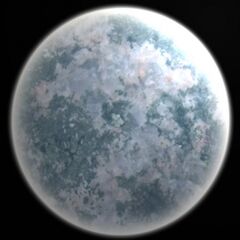
This is what phosphorus planet may look like
Phosphorus planet is a hypothetical class of planet with surface covered in lakes or oceans of phosphoric acid with clouds made of phosphoric acid in the atmosphere. Kepler-55c is speculated to be a phosphorus planet.
Appearance[]
Viewed from space, phosphorus planet would appear white, just like white phosphorus itself, including clouds as shown in the image.
Atmosphere and climate[]
Phosphorus planets' main climates are precipitation and "white fog." Unlike Earth, phosphorus planets use phosphoric acid as a "variable gas" instead of water vapor as it is on Earth. For example, there are phosphoric acid rain or phosphoric acid snow instead of water rain or water snow. Those planets tend to be hot, at around 340°F (171°C), just as hot as inside the oven! Their atmospheres tend to be composed mostly of phosphorus trioxide (P4O6) with variable amounts of phosphoric acid vapor (H3PO4) and trace amounts of phosphorus trichloride (PCl3), phosphine (PH3), carbon dioxide (CO2), and other gases.
Life[]
The life-bearing status on phosphorus planets are fair, even though phosphorus is toxic to many forms of life on Earth. But some forms of higher life somewhere in our galaxy require phosphorus in the form of compounds to thrive. It is predicted that during the photosynthesis, phosphoric acid (H3PO4) and phosphine (PH3) are combined with carbon dioxide (CO2) to produce triphenylphosphate (OP(OC2H5)3), phosphorus trioxide (P4O6), and oxygen (O2) using the balanced equation below:
- H3PO4 + 4 PH3 + 6 CO2 + energy → OP(OC2H5)3 + P4O6 + 3 O2.
It is also predicted that animals drink phosphoric acid and eat foods rich in organophosphates. Like terrestrial animals, they inhale oxygen and exhale carbon dioxide on phosphorus planets. The main biogeochemical cycle on phosphorus planets is the phosphorus cycle compared to the carbon cycle here on Earth.
Rarity[]
Phosphorus planets are rare in our galaxy. There are an estimated 427 million phosphorus planets in our galaxy alone, making it the third least abundant composition class of planet after chlorine planet and iron planet. Phosphorus planets make up 0.08% of all 524 billion terrestrial planets and 0.05% of all 820 billion planets in our galaxy. Still phosphorus planets are 133.3 times more abundant than chlorine planets, the rarest class of terrestrial planet, because phosphorus is seven times more abundant than chlorine in the universe, thus phosphorus is less reactive than chlorine.
Related links[]
| ||||||||||||||